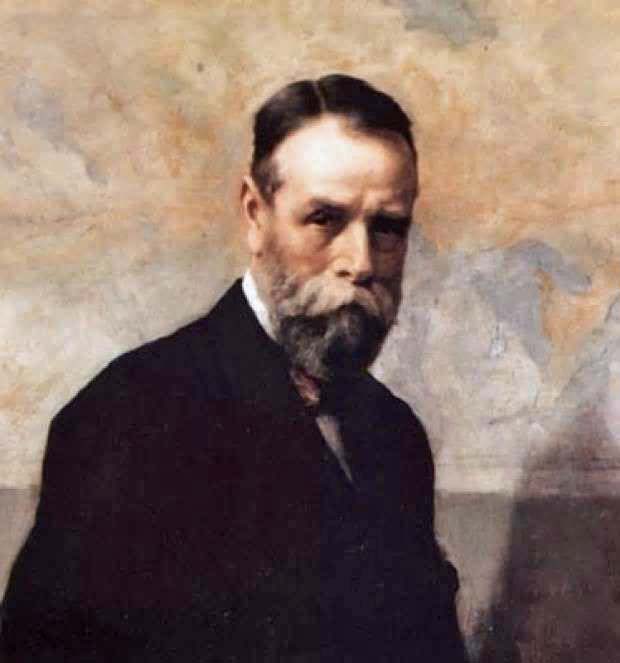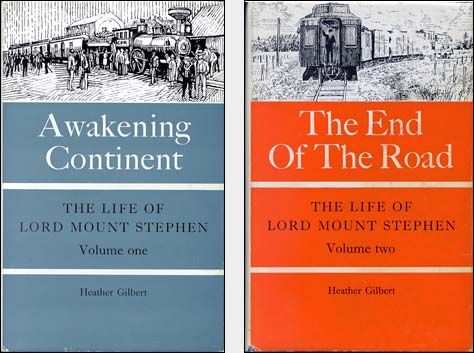
Calgary Alberta - "Come and dine with me tomorrow evening in our car at Calgary."
So wrote Canadian Pacific Railway (CP) president George Stephen (1829-1921) in an 1883 telegram to Father Albert Lacombe, a Roman Catholic
missionary.
Maybe.
The legend of Stephen's Calgary meeting with Lacombe dates as far back as 1892, when A.B. Routhier detailed the story in the Montreal Gazette.
The CP's surveying activities along its right-of-way near Blackfoot Crossing had provoked the Siksika and could have led to violence.
Lacombe's mediation allowed railway development to resume.
In gratitude, according to the story, Stephen and his party, which comprised the CP brass, hosted the missionary at a fine dinner in their railway coach and
declared him president of the line for one hour.
In Routhier's telling, Stephen pointed westward and asked, "What are those?"
"They are the Rocky Mountains," Lacombe answered.
"And do they think that they will bar our way? We will see. If they do not make way for us we will ride across on their backs," Stephen
replied.
The first issue of the Calgary Herald confirms Stephen's visit.
His party arrived at 16:45 on 27 Aug 1883 more than two years before Stephen's cousin Donald A. Smith, better known as Lord Strathcona, pounded in the Last
Spike at Craigellachie, B.C.
The end-of-track was still a short distance west of Calgary.
But the Herald made no mention of a meeting with Lacombe, and neither does Heather Gilbert's two-volume biography of Stephen.
May or May Not be True
"The pleasant story that Father Lacombe was made president of CP for an hour in recognition of his intervention may or may not be true," noted
historian W. Kaye Lamb.
And Routhier's dialogue about the Rocky Mountains is fanciful.
"Unfortunately the smokiness of the atmosphere prevented the gentlemen from obtaining the fine view of the mountains," the unnamed Herald reporter
wrote of Stephen's visit.
"But they were unanimous in the opinion that Calgary is destined to become an important place."
Like his famous cousin, Stephen was born in Banffshire, Scotland.
Both emigrated to Canada as young men and prospered in business.
Stephen became a prominent Montreal financier, and in 1876, president of the Bank of Montreal.
The cousins were central figures in CP, which was incorporated in 1881 under Stephen's presidency.
Stephen led the company through its four year construction period and on until 1888, when he stepped down and moved to England.
"In function, fact, and theory, Calgary was a CP creation," wrote historian Max Foran nearly a century after the railway's arrival.
Such was, and remains, the legacy of Stephen's enterprise in our city.
The Townsite of Calgary
When it arrived in 1883, CP ignored the existing settlement in what is now the Inglewood neighbourhood and placed its station on its own property to the
west, an entire section of land that it received as part of a 25 million acre incentive from Ottawa.
In early 1884, CP registered the Townsite of Calgary and named its streets and avenues for company officials, including Stephen's 1883 travelling companions,
vice-presidents R.B. Angus, Duncan McIntyre, director Smith (Stephen's cousin), and general manager William Cornelius Van Horne.
These men became the original namesakes for today's 6th, 7th, 11th, and 12th Avenues.
The principal commercial road was named Stephen Avenue.
(Lacombe, a community 25 kilometres north of Red Deer, is named for the missionary that Stephen might or might not have met in Calgary.)
Stephen made his first through trip on the finished line in the summer of 1886.
When his special train passed through Calgary at mid-day on 31 Jul 1886 he had his chance to see the street that was named for him.
But there is no available evidence that Stephen left the station or that he spent any time here on his return trip to Montreal.
But on his journey, he would have seen Mount Stephen, which had been named for him.
(In 1891, Stephen in turn named himself for the mountain, accepting a peerage as Baron Mount Stephen of Mount Stephen, British Columbia, and Dufftown,
Banffshire.)
Perhaps he walked along another Stephen Avenue in adjacent Field, B.C., a street that still bears his name.
And he would have stopped at, or passed by Banff, a CP station named two or three years earlier for the county town of his native Banffshire.
Asked in 1889 whether he had chosen the name, he replied, "Yes. Ever so many stations on the Canadian Pacific have got Banffshire
names."
But the Banff station that he saw in 1886 was about three kilometres east of the present townsite.
It moved in 1888.
Final Visit to Calgary
In 1889, Stephen's brother William spent time in Calgary, and perhaps he shared his observations.
Finally, on a return trip to Canada in 1891, Stephen joined other CP dignitaries on a Calgary visit.
He arrived on 7 Sep 1891 in his private car, the Matapedia, and he came back the following day after a brief trip to Edmonton.
According to the Herald, "His Lordship spent some time on the streets and in conversation with people of the Town", including Mr. McGregor of
Molson's Bank and Mr. Thompson of the Soda Water Works, both of whom hailed from his Banffshire hometown.
Almost certainly, Stephen never returned to Calgary.
By-law Number 528 of 1904 changed avenue names to numbers, although for a few years, advertisements and newspaper articles kept referring to Stephen Avenue as
well as its new designation, 8th Avenue.
But Stephen's name returned in 1981 when the Stephen Avenue Mall Alliance persuaded the city to rename the pedestrian mall that had been created along the
avenue a decade earlier.
One more honour remained.
CP headquarters moved from Montreal to Calgary in 1996, and a dozen or so years later, Stephen's statue in the eastern city's historic Windsor Station made the
same journey.
The 106-year-old bronze now stands in the company's E.H. Harrison Campus in Ogden.
Harry Sanders.
 The two books
about Stephen by Heather Gilbert are "Awakening Continent" (1965) and "The End of the Road" (1977) published by Aberdeen University Press
Farmers Hall Aberdeen UK AB9 1FX.
The two books
about Stephen by Heather Gilbert are "Awakening Continent" (1965) and "The End of the Road" (1977) published by Aberdeen University Press
Farmers Hall Aberdeen UK AB9 1FX.

provisions in Section 29 of the Canadian
Copyright Modernization Act.


